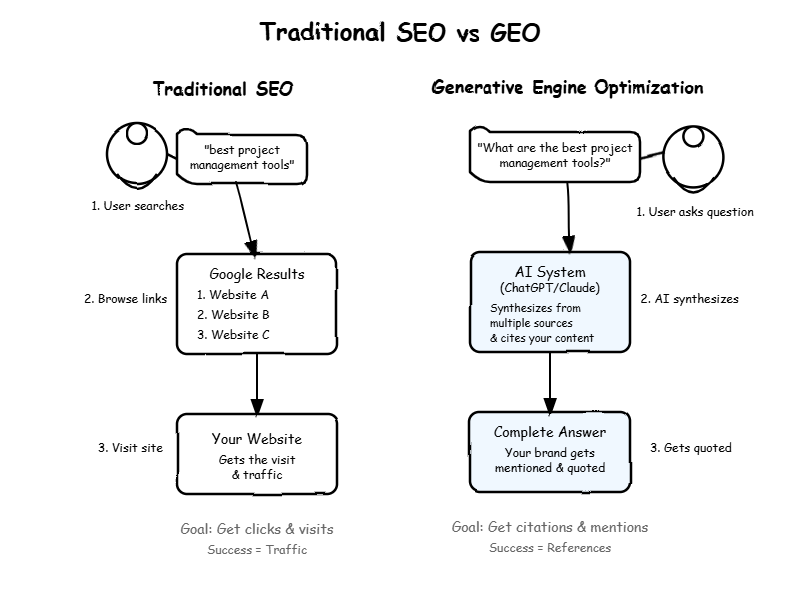Google’s market share dropped below 90% for the first time since 2015. Meanwhile, ChatGPT now handles over 10 million queries daily, and 8% of Americans have switched to using it as their primary search engine.
If those numbers don’t grab your attention, consider this: 56% of content marketers report declining organic traffic as AI-generated summaries replace traditional click-through visits. The way people search for information is fundamentally shifting, and most businesses are completely unprepared.
Enter GEO — Generative Engine Optimization. It’s the practice of optimizing content not for search rankings, but for being cited and referenced in AI-generated responses. While traditional SEO focused on getting clicks, GEO is about getting quoted.
What exactly is GEO?
Think of traditional SEO like optimizing a storefront window. You arrange your display, pick the right keywords, and hope people walking by notice and come inside. The goal is getting visitors to your website.
GEO works differently. Instead of trying to get website visits, you’re optimizing for inclusion. When someone asks ChatGPT, Claude, or Perplexity a question, you want your content to be part of the answer they generate. Your expertise gets quoted even when the person never visits your site.
Consider this scenario: A startup founder asks ChatGPT, “What are the best project management tools for remote teams?” The AI synthesizes information from dozens of sources and provides a comprehensive answer. If your content is optimized for GEO, your recommended tool might be the one mentioned by name — even though the founder never clicked through to your website.
This represents a fundamental shift. Traditional search engines provide lists of links. AI-powered search engines provide complete answers, often eliminating the need to visit external websites.
The numbers paint a clear picture
This isn’t some distant future scenario. The adoption numbers are staggering:
- 300 million people use ChatGPT weekly
- 63% of marketers now prioritize generative search optimization
- 65% of organizations regularly use generative AI tools, doubling from the previous year
- Research shows GEO can boost visibility in AI responses by up to 40%
These aren’t tech enthusiasts experimenting with new gadgets. This is mainstream adoption happening in real-time across industries.
How GEO actually works
The biggest misconception about GEO is that it requires abandoning everything you know about content optimization. Actually, there’s significant overlap with traditional SEO best practices. But AI-powered search engines look for different signals when deciding what to reference:
Citations and authority carry more weight
AI systems prefer content they can verify and trust. Including citations, expert quotes, and relevant statistics significantly increases your chances of being referenced. Backing up claims with solid sources isn’t just good practice — it’s essential for GEO success.
Structure and clarity win over keyword density
While traditional SEO often rewards keyword repetition, AI systems prioritize content that’s well-organized and easy to parse. Clear headings, bullet points, and direct answers to questions help these systems extract and reproduce your content effectively.
Phrases like “in summary” or structured formatting act as signals that help AI models identify key information worth referencing.
Context matters more than keywords
Traditional SEO focuses heavily on specific keyword targeting. GEO requires comprehensive, contextually rich content that AI systems can easily understand and synthesize. Instead of keyword stuffing, you need natural explanations that can be easily quoted and referenced.
The fundamental difference: clicks vs citations
The distinction between SEO and GEO comes down to different success metrics and optimization targets:
Traditional SEO optimization:
- Targets search engine rankings
- Focuses on generating website traffic
- Measures success through clicks and rankings
- Optimizes for human search behavior patterns
- Builds authority through backlinks and domain strength
Generative Engine Optimization:
- Targets inclusion in AI-generated responses
- Focuses on being cited or referenced
- Measures success through mentions and citations
- Optimizes for AI comprehension and synthesis
- Builds authority through expertise and verifiable information
Success is no longer measured by click-through rates, but by reference rates: how often your brand or content appears as a source in AI-generated answers.
The fundamental difference: Traditional SEO aims for clicks, GEO aims for citations

Why this matters right now
You might think this is something to address later. That would be a mistake. Early adopters are already seeing results, and the window for easy wins is closing rapidly.
We’re witnessing the early stages of a major search paradigm shift. Traditional search was built on links and algorithms. GEO is built on language understanding and content synthesis. Companies that adapt now will dominate tomorrow’s AI-powered search results.
The stakes are real. Content marketers are already reporting traffic declines as AI-generated summaries replace traditional search results. If your content isn’t optimized for GEO, you’re likely losing visibility without realizing it.
Getting started with GEO
The good news: you don’t need to abandon your existing SEO strategy. Smart companies are optimizing for both traditional search and AI-powered search simultaneously. Here’s how to start incorporating GEO principles:
Make your content quotable
AI systems love authoritative, standalone statements. Include expert quotes, relevant statistics, and clear declarations that could work as complete answers to common industry questions. Think of each key point as a potential quote that could appear in an AI response.
Structure for AI comprehension
Use clear headings, numbered lists, and summary sections. AI models scan for organizational structure when deciding what to reference. Well-structured content is more likely to be extracted and cited.
Answer questions directly
Stop dancing around topics. Provide clear, direct answers to questions your audience asks. Create FAQ sections and ensure key information appears within the first few sentences of relevant sections. AI systems favor content that directly addresses user queries.
Provide comprehensive context
While traditional SEO might focus on specific keyword targets, GEO benefits from thorough coverage. Explain relationships between concepts, provide background information, and help AI systems understand the complete picture of your topic area.

Authority signals: what AI systems actually look for
When AI systems decide what content to cite, they scan for specific authority signals that indicate trustworthiness and expertise. Understanding these signals is crucial for successful GEO implementation.
The key authority signals AI systems recognize
Expert citations and quotes: AI systems prioritize content that references recognized authorities. Instead of making unsupported claims, successful GEO content includes statements like “According to Dr. Sarah Johnson, a digital marketing researcher at Stanford University…” or “As reported in the 2024 Content Marketing Institute study…”
Statistical backing: Specific numbers and research findings carry significant weight. Rather than saying “many businesses struggle with this,” GEO-optimized content states “73% of B2B companies report challenges with lead qualification, according to HubSpot’s 2024 State of Marketing report.”
Source attribution: Clear linking to original research, studies, and authoritative websites signals credibility. AI systems favor content that can be verified and traced back to reputable sources.
Author expertise indicators: Professional credentials, company affiliations, and demonstrated experience in the topic area all contribute to content authority in AI evaluations.
Traditional SEO paragraph vs GEO-optimized paragraph
Here’s how the same information might be presented differently for traditional SEO versus GEO optimization:
Traditional SEO approach:
“Email marketing remains one of the most effective digital marketing channels for businesses. Companies that use email marketing see higher ROI compared to other marketing methods. Email marketing campaigns can generate significant revenue when done correctly. Best practices include segmentation, personalization, and mobile optimization for email marketing success.”
GEO-optimized approach:
“Email marketing delivers a median ROI of $36 for every $1 spent, according to Litmus’s 2024 State of Email report. Dr. Email Marketing Expert from Marketing University explains: ‘The key to email success lies in three critical areas: audience segmentation, which can improve open rates by 14.31% (Campaign Monitor, 2024), personalization beyond just names, and mobile-responsive design since 81% of emails are now opened on mobile devices (Mailchimp, 2024).’”
The difference: The GEO version includes specific statistics, expert quotes, source attribution, and concrete data points that AI systems can easily extract and cite. The traditional SEO version focuses on keyword repetition but lacks the authoritative backing that AI systems prioritize.
Structuring posts for both SEO and GEO success
The most effective content strategy combines both approaches. Here’s how to structure a blog post that performs well in traditional search and AI-powered search:
1. SEO-optimized headline with GEO-ready introduction:
Use your target keyword in the headline (SEO), then open with a compelling statistic or expert quote (GEO). For example: “Email Marketing Best Practices: 7 Strategies That Work” followed by “Email marketing generates $36 in ROI for every dollar spent, but 73% of marketers struggle to achieve these results, according to recent industry research.”
2. Clear H2 and H3 structure:
Traditional SEO benefits from heading hierarchy, and AI systems use these headings to understand content organization. Make headings descriptive and include natural keyword variations.
3. Authority-rich body content:
Each major point should include at least one of these GEO elements: expert quotes, statistical backing, or source citations. This satisfies AI requirements while maintaining natural readability for human visitors.
4. FAQ sections:
Include a frequently asked questions section that directly answers common queries. Format these as H3 headings with direct, quotable answers below. This serves both traditional search intent and AI systems looking for specific information to cite.
5. Summary sections:
Use phrases like “In summary,” “Key takeaways include,” or “The main points are:” followed by bullet points. AI systems specifically look for these summary indicators when extracting key information.
Example structure:
- Introduction with hook statistic (GEO) + target keyword (SEO)
- H2: Main topic with expert quote and research citation
- H3: Specific tactic with implementation steps
- H3: Another tactic with case study data
- H2: Common challenges (addresses search intent)
- H3: FAQ format with direct answers
- H2: Summary with “Key takeaways” bullet points
This approach ensures your content ranks well in traditional search results while positioning it perfectly for AI citation and reference. The key is making every claim verifiable and every important point easily extractable by AI systems.
The transition is already happening
This isn’t speculation about future possibilities. Apple recently announced that AI-powered search engines like Perplexity and Claude will be integrated into Safari. Google’s traditional search dominance faces real challenges for the first time in decades.
Paradoxically, despite predictions that AI would decrease Google’s market share, traditional search volume actually grew 21.64% from 2023 to 2024. Google still processes over 14 billion daily searches compared to ChatGPT’s 37.5 million. But ChatGPT has captured 61.3% of the AI-powered search market, indicating a significant shift in user behavior.
We’re in a transition period where both traditional and AI-powered search matter. The winners will be organizations that optimize for both.
Start now, but start smart
The digital marketing landscape changes rapidly, and keeping up can feel exhausting. But GEO isn’t about discarding everything you know and starting over.
The fundamentals of quality content creation still apply. Authoritative sources, clear structure, and valuable information remain the foundation of both SEO and GEO. The difference lies in understanding how AI systems process and utilize that information.
Begin small. Start incorporating GEO principles into your existing content strategy. Add more citations, improve content structure, and focus on providing direct, comprehensive answers to audience questions.
Search is evolving rapidly, and understanding GEO isn’t just about staying competitive — it’s about ensuring your expertise remains discoverable in an AI-powered world. The companies that master both traditional SEO and GEO will control visibility in tomorrow’s search landscape.
The conversation is just beginning, and there’s still time to get positioned advantageously. What questions do you have about implementing GEO in your content strategy?
Learn more
- Generative Engine Optimization: The Future of SEO
- What is generative engine optimization (GEO)?
- Generative Engine Optimization (GEO): What to Know in 2025
- Generative Engine Optimization (GEO) Statistics
